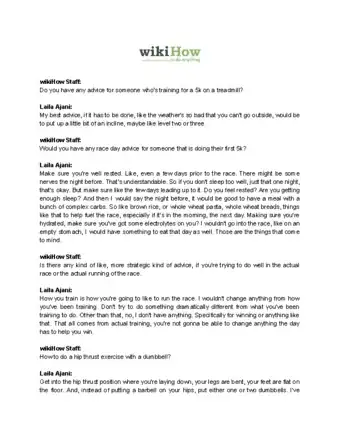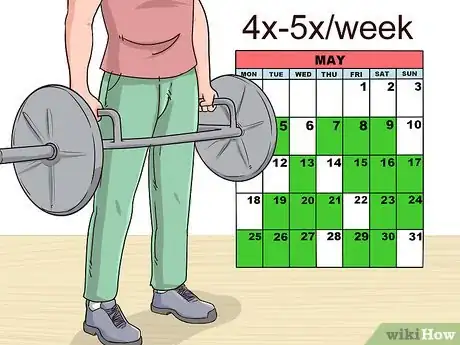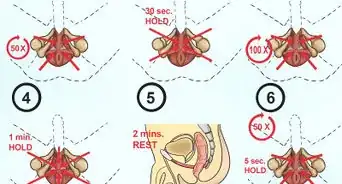This article was co-authored by Laila Ajani. Laila Ajani is a Fitness Trainer and founder of Push Personal Fitness, a personal training organization based in the San Francisco Bay Area. Laila has expertise in competitive athletics (gymnastics, powerlifting, and tennis), personal training, distance running, and Olympic lifting. Laila is certified by the National Strength & Conditioning Association (NSCA), USA Powerlifting (USAPL), and she is a Corrective Exercise Specialist (CES).
There are 10 references cited in this article, which can be found at the bottom of the page.
This article has been viewed 16,634 times.
Acquiring a more tone physique does not have to be over-complicated. With persistence and dedication anyone may achieve a leaner, tighter body without having to gain muscle mass. If one is willing to evaluate themselves accurately, make and track progress honestly, and maintain their standards, they will be able to effectively tone and not bulk in the process.
Steps
Setting Your Goals
-
1Set a goal. Make it clear what exactly you want to accomplish in what amount of time. This will help you stay motivated and serve as a reminder of why you are doing what you do. Ensure it is a realistic goal that can be met. People are much more likely to succeed if a goal is set.[1]
- Example of a realistic goal - "I want to be noticeably more tone in two months."
- Example of an unrealistic goal - "I want to be incredibly tone overnight."
-
2Weigh yourself. The ideal time to weigh yourself is upon waking up, and on an empty stomach daily.[2] This baseline weight result will be useful in further calculations and planning. It also assists you in determining whether you would like to aim to lose excess body-fat as well.
- Do not be deterred by the number on the scale. You are trying to better yourself, not bring yourself down.
- Skewed numbers that are rounded or falsified are only detrimental to your progress.
Advertisement -
3Calculate your daily caloric needs. Knowing how many calories your body is burning per day is vital in knowing how much to eat. This involves calculating your BMR (Basal Metabolic Rate) and using it in the Harris Benedict Formula.
- Everybody's body reacts differently. You must take time to see what a rough baseline of your calorie intake should look like.
- For more information on how this is done, see: Count Calories
-
4Take initial pictures. Pictures will be the biggest asset in tracking your progress of toning. Since the main focus is on visual changes, these pictures should be an unedited indication of where your journey starts.
- Ensure lighting, poses, and clothing can be easily replicated in the future.[3]
- Don't be afraid to show some skin because you'll need to compare your body in the future - not your clothes.
-
5Identify bad habits. Bad habits can hinder progress in many regards to your goal. Quitting them (or at least moderating them) will improve results of your work.[4] Bad habits include:
- Drinking alcohol
- Doing drugs
- Smoking
- Eating unhealthy foods excessively
Toning Up
-
1Create a journal. A journal will make you accountable for whatever happens along your journey towards being more tone. It will also help pinpoint what possible reasons progress has halted or plateaued, and will allow you to adjust accordingly. Be sure to include the same information as Part 1 and record it at least once weekly. This information includes:
- Current weight
- Caloric needs
- Caloric intake/day
- How frequently bad habits are being performed.
-
2Create a routine. Studies have shown that having some sort of routine makes many people more successful.[5] By implementing a day-to-day routine, it will become second nature to work towards your goal. Eventually, it may become bothersome to not fulfill the routine. Some aspects to consider including in a routine:
- Daily tasks
- A to-do list
- Allotment of time
- Eat a certain amount of calories
-
3Lift weights. Lifting weights can assist in not only building muscle, but burning body fat too.[6] This is ideal for anybody looking to have a more aesthetic appearance. Anywhere from a half hour to an hour and a half should be sufficient time in the gym.
- Aim for high reps with moderate intensity. You should feel a decent resistance but should be able to do 15 repetitions 3 times for each exercise. [7]
- If you want to tone up without getting bulky, it might be a good idea to keep your reps under 15. A number between 8 to 10 is usually a good point.
- Muscles need approximately 48 hours of rest to recover and minimize the chance of injury. [8] Spend this downtime working on other muscle groups.
- A common misconception is that lifting weights will automatically make you bulk up. This is NOT true, as lifting weights can help you get leaner and stronger.
- Cardio and body weight exercises can be implemented, although will prove to be less effective than weightlifting.
-
4Diet with adequate protein. Changing your body starts in the kitchen. It is suggested to eat roughly 1 gram (0.04 oz) of protein per pound of body weight per day.[9] This will help your muscles get the nutrients they need to develop.
- Many meats such as fish and chicken are high in protein. Alternatively, vegetarians may consume foods such as lentils and beans to reach their protein goal.
- To lose body fat and develop your muscles you should eat about 200-500 calories below your daily caloric needs.
- To try to maintain your current weight and only develop your muscles you should eat your daily caloric needs up to 200 calories over/under.
-
5Drink enough water. Water works much like oil does to a car, but for the human body. For your body to operate smoothly, especially under the stress of diet change and working your muscles, you must remain hydrated.
- Water intake should be roughly 3.7 liters/day for healthy men and 2.7 liters/day for healthy women.[10]
- An easy way to consume enough water is to replace all other beverage consumption with water.
- If you feel as though you are really thirsty, chances are you are already dehydrated.
- Although water is important, make sure to drink it slowly during a workout if you are feeling nauseous while exercising.
-
6Get enough rest. Although the goal is not to bulk, muscles are repaired and grow while you are sleeping. Since you are working out to tone them, they need time to recover before being worked again.
- The average person needs roughly 8 hours of sleep for a full night's rest.
- Inadequate sleep can lead to several health risks.
-
7Take progress pictures. Try to replicate the same poses and lighting as your initial pictures. This should be done at least once weekly to track any visual differences your efforts have caused.
- Accompany this with your journal to have a complete log of your journey.
- Date the pictures accordingly to know how long it took to reach your milestones along the way.
Maintaining Your Progress
-
1Assess your current physique. Upon reaching your goal date, determine if you were successful in completing your goal physique. You may reflect on the pros and cons of the steps you took and what benefits you reaped. From there, you may determine if you are content with where you are.
- If you are not content, you may continue to make and track progress and set a new goal date. Never be deterred.
-
2Maintain your new body. With a great body comes great responsibility. Now it is up to you to maintain your physique and not stress on making progress.
- If you do not attempt to maintain some level of fitness or health, your body will slowly revert to how it was before making any progress.
- Maintaining a healthy, fit body is more so a lifestyle than just going to the gym.
Warnings
- If incorporating supplements to help, do not exceed the recommended dosages.⧼thumbs_response⧽
- Ensure to consult with a qualified physician for any questions regarding health concerns.⧼thumbs_response⧽
Expert Interview

Thanks for reading our article! If you'd like to learn more about working out, check out our in-depth interview with Laila Ajani.
References
- ↑ https://www.huffingtonpost.com/marymorrissey/the-power-of-writing-down_b_12002348.html
- ↑ https://www.aworkoutroutine.com/weighing-yourself/
- ↑ http://thebettyrocker.com/how-to-take-progress-pictures/
- ↑ https://www.bodybuilding.com/fun/topicoftheweek99.htm
- ↑ https://www.huffingtonpost.com/cathryn-lavery/morning-routines_b_8042428.html
- ↑ https://www.bodybuilding.com/content/build-muscle-and-lose-fat-simultaneously.html
- ↑ http://www.health.com/health/gallery/0,,20689183,00.html#toning-exercises-0/
- ↑ https://www.bodybuilding.com/content/recuperation-and-muscular-growth.html
- ↑ http://www.acaloriecounter.com/diet/how-much-protein-per-day/



















-Step-24.webp)















































